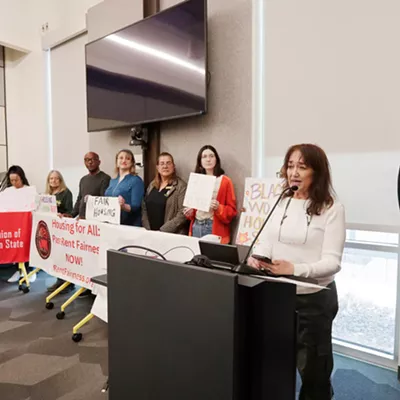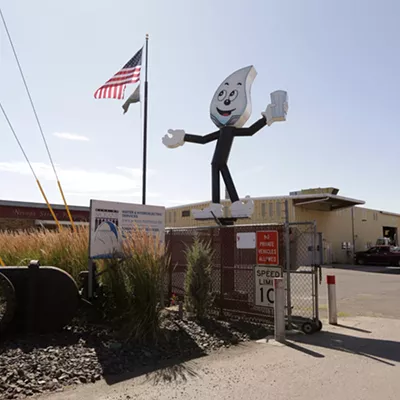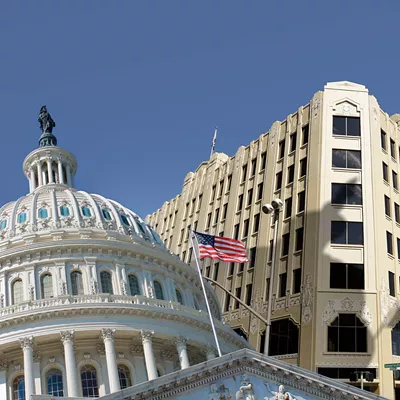
A good news story is not measured by likes, clicks, shares or any other tech-infused yardstick.
As journalists, we prefer to measure by impact, which is a slippery thing to quantify. Is telling the story of people dying in shabby, downtown Spokane buildings significant? Yes. And so is reporting on tribal scientists working to re-establish threatened wildcats. And digging into the continuing morass that is Camp Hope. And describing how national policy affects us locally.
In other words, journalism has meaning when it tells the stories of our community. And that's what we've done. This year, the Inlander news team covered the most important issues of the day — from abortion rights to homelessness and from labor disputes to gun violence. We brought our investigative skills to topics others may have ignored, and told stories with precision and intention.
And we did it accurately and truthfully, as independent journalists working for a family-owned newspaper to make the world a fairer, more accountable place.
WILDLIFE RESTORATION
At first glance, wild lynx look like adorable, oversized house cats with tufted ears and massive paws that allow them to run atop the snow hunting for hares. Despite their important role in Inland Northwest ecology, the wildcat species has been over-hunted and all but disappeared from the Washington mountain ranges where they once thrived.
The Colville Confederated Tribes are aiming to restore that balance within the Kettle Range, as their science team works to trap 50 lynx from Canada and relocate them to the reservation over five years.
As we reported earlier this year, the team finished the first trapping season of the project, capturing nine lynx mature enough to be tagged and released in Washington. GPS collars have enabled the team to track most of the animals' movements. Two of that first cohort died by late spring, but the others seem to be thriving along the backbone of the Kettle Crest, including one female that may have had kittens.
"Over the course of the year, we had two males and two females return to Canada," said Rose Piccinini, the project's lead biologist, in November. "One of the females traveled south again and has returned to the North Half" of the traditional reservation area.
The team got an earlier start for the second trapping season this fall, capturing and relocating 10 lynx before the end of November.
One interesting finding? Two of the captured lynx were runaways from the first group who made it something like 150 miles across the mountains and a major highway, says Richard Whitney, senior manager of the tribes' wildlife division.
"One of the theories of why we didn't have many lynx down here was just that the Kettles weren't effectively connected to that population up there, they were cut off," Whitney says, noting the Canadian highway was a major concern. "What we're kind of seeing is these cats cross that with no problem."
The project is one of several wildlife reintroduction efforts by the tribes. They're also working to bring salmon back to parts of the Columbia and Spokane rivers. In May, the Colville Confederated Tribes, in partnership with other Inland Northwest tribes, released juvenile salmon outfitted with tracking devices at the base of Chief Joseph Dam to start their journey out to the Pacific Ocean. If enough of those fish return to the dam as adults (roughly two to four years from now), it could help make the case for helping the species return to areas that were made impassable by dams. (SW)
CAMP QUAGMIRE
Earlier this month — to the horror of many local officials — Camp Hope celebrated its one-year anniversary.
What started as a small protest outside City Hall over a lack of low-barrier shelter space morphed into a political firestorm highlighting the region's larger homeless crisis. This summer, the East Central homeless encampment had more than 600 residents — all crammed into one city block. The camp's size made it the largest in the state, and possibly one of the largest in the country.
Camp Hope is smaller now. The Washington State Department of Transportation, which owns the land the camp is on, reports 198 residents. But the contentious debate over what to do about the camp hasn't gone anywhere. The governor, mayor, county commissioners, sheriff, police chief, state attorney general, commerce director and other powerful officials have all been dragged into the fray.
Everyone says they want to see Camp Hope gone eventually — the question is when and how. The state government doesn't want to clear the camp until there's adequate shelter space for everyone. The city, county and local law enforcement are pushing to close the camp quickly, but their plans are tied up in lawsuits and constitutional questions about shelter space. Somehow, after more than a year, basic questions about Spokane's shelter capacity are still the subject of debate.
After 12 months of fiery letters, lawsuits and dueling press conferences, Camp Hope looks less like an unsanctioned encampment and more like a disaster zone. It's an ongoing humanitarian crisis: with a large white service tent, fencing, generators, floodlights, security patrols, mobile health services and hundreds of people — a majority of them originally from Spokane — preparing to spend another full winter in snow-covered tents. (NS)
DEATH AND MERCY
New Washington Apartments tenant Joseph Sargent isn't the sort of person most people have sympathy for. He knows that. He's a sex offender with a conviction for child porn. And before that, he served 20 years in prison for murder and arson. If it wasn't for the troubled New Washington and Wolfe apartments, few places in society would take him.
"We're like the dregs of society who end up here," Sargent says.
The New Washington and Wolfe aren't just home to sex offenders, but also to people with mental illness and drug addiction, and those in serious poverty. For some folks, the $450 rent here is all they can afford.
As part of our "Out of Reach" series on the housing crisis, we investigated the New Washington and Wolfe apartments this year. We discovered that 19 people died in these very low-income apartments over six years, including from heat exhaustion, drug overdoses and — in one case — murder.
By that standard, 2022 was a good year. Sargent isn't aware of anyone in the New Washington Apartments dying. He says management has tried to make more of an effort to improve things, like by covering electrical outlets or fixing holes in the ceiling.
The shared bathrooms and kitchens are often worse than just messy. He says someone kept a raw turkey in the community kitchen, and even when it disappeared, the pool of turkey juice remained.
"There's that red juice in there, like a big petri dish of salmonella, just brewin' away," Sargent says.
And there's always a pest problem: bed bugs and mice. Sargent says that the owner put out sticky traps for the mice. But when Sargent saw one trapped and suffering in the kitchen, he tried to rescue it. Sargent killed his wife and is bothered by seeing a mouse suffer.
"Nobody sees the irony better than me," Sargent says. "I'm like, 'What happened to me?'" (DW)
TRAIN PAIN REMAINS THE SAME
This year, we sat down with local BNSF Railway engineer Shawn Blackburn and chatted with him about how an always-difficult but well-paying job — working on the railroad — had turned into a nightmare. The railroad had moved to a Kafkaesque scheduling system that charged employees "points" from a limited pool with each day taken off, and made it almost impossible to earn points back. And considering that schedules were always wildly unpredictable, it left him seriously sleep-deprived.
Since then, we've had months of contract negotiations, union votes, a strike threat and — most recently — federal legislation imposing a new labor contract in order to avoid disruption to the nation's freight system.
The good news? "We did get a 14 percent pay increase," Blackburn says.
The bad news? Pay wasn't really the problem. "It's a separate issue from their draconian attendance policy that they decided out of the blue to institute," he says.
He says the new contracts do guarantee them one extra day of sick leave on their birthday.
"It's peak season right now. That means there are a lot of trains bringing Christmas presents," he says. "Last month I worked 240 hours on the train. I spent 150 hours in the hotel."
Add on commuting time, and that's more than 100 hours a week away from his family. But what else is he going to do?
"Maybe I can get to one of these coveted Holy Grail land of milk and honey [railroad] yard jobs," Blackburn says. It used to be that jobs in the railroad yard were the worst of them all. It was monotonous and didn't pay very well. But at least they have a predictable schedule.
"You basically switch boxcars around," Blackburn says. "There's a morning shift, there's an afternoon shift, and there's a night shift, and they have two set days off a week." (DW)
VERY NORMAL ELECTION
In October, we reported on how the election denialism sparked by Donald Trump's loss in 2020 was continuing to haunt local elections — leading to self-appointed drop-box watchers, a flurry of public records requests and unfounded concerns about "mules" stuffing drop boxes with votes for Democrats.
But the election itself went off without a hitch. The armed vigilantes didn't show up at local drop boxes, and a state-mandated audit found zero evidence of any errors in the vote counting process.
Retiring Washington state Rep. Bob McCaslin, a Republican who has flirted with election conspiracies in campaign materials, did end up paying thousands of dollars for a partial recount in his race against the incumbent county auditor, Vicky Dalton. But it changed the final results by exactly zero votes, and he still lost the race.
The election was still historic in other ways.
Two new seats were added to the Spokane County Board of Commissioners this year, bringing the total to five. In November, voters chose two Democrats to fill those seats. In doing so, they shifted the balance of power on a governing body that's been solidly red since 2006. The two newcomers — Chris Jordan and Amber Waldref — will take office in January. They'll struggle to overcome the Republican majority, but their presence is still likely to shake things up and bring more debate to the county government. (NS)
ABORTION RIGHTS SPLINTERED
Earlier this year, the U.S. Supreme Court voted 5-4 to overturn Roe v. Wade, removing federal protections that for nearly 50 years ensured the right to an abortion in every state. The decision was groundbreaking enough that someone leaked a draft of the final version more than a month before the court officially published its ruling in June.
As we reported in May, the leaked decision elicited strong emotions from both abortion rights supporters and anti-abortion groups.
Protests quickly popped up across the nation, as many learned they might soon lose the ability to obtain an abortion in their state. Some worried about accessing safe health care should they miscarry or need help with unexpected pregnancy complications. Others questioned how the court could argue the Constitution doesn't protect bodily autonomy and privacy.
At a protest in Spokane, a woman dressed as a handmaid (from Margaret Atwood's dystopian novel about forced pregnancy) said she felt like the fears that sparked the Women's March after former President Donald Trump's 2016 election had become a reality.
"Six years ago, when we had the Women's March, people were like, 'Oh, calm down. Don't worry, this is never gonna be overturned. No one needs to worry about Roe v. Wade, that's safe,'" she said. "Well, we were not overreacting, and this is exactly what happened."
Meanwhile, anti-abortion groups cheered the decision, knowing their decades of efforts to restrict abortion had finally resulted in change. Pastor Ken Peters, who used to lead the Church at Planned Parenthood anti-abortion protests in front of Spokane's health center, said the day he learned of the decision was "probably one of the greatest nights of my life."
Several states, including Idaho, had already passed trigger bans to immediately ban abortion if Roe was ever overturned. (Many of those bans await court decisions.) Some also criminalized abortion, putting health providers at risk of fines and prison time.
Abortion remains legal in about half of the country, including in Washington state, which legalized the procedure before Roe, and is likely to see more patients arrive from out of state. (SW)
GUNS, GUNS, GUNS
In spring this year, a horrific string of mass shootings — including one that took the lives of 19 students and two teachers at an elementary school in Uvalde, Texas — highlighted the country's grim relationship with firearm-related violence.
In response, students at Lewis and Clark and other Spokane high schools walked out of class and organized protests calling on elected officials to do something. Earlier this month, the threat reared its head again when a false active shooter threat terrified parents and sent Lewis and Clark into lockdown.
On a local level, some work has been done to improve firearm safety.
This summer, we reported how the Spokane Police Department had confiscated a record-breaking number of guns — mainly from people facing domestic violence protection orders. That work was aided by a domestic violence firearms analyst who was hired through a grant from the U.S. Department of Justice and works to follow up on protection orders and make sure people are actually complying when ordered by courts to surrender their guns. Local officials have touted the program's success, and in September this year, the DOJ awarded an additional grant to continue the work. (NS)
2. "Sheriff Ozzie walks nonexistent homeless camp while talking Camp Hope, dirty politics" Nate Sanford (Sept. 28)
3. "As temps reach 104, Spokane orders WSDOT to remove cooling tent at state's largest homeless camp" Nate Sanford (July 29)
4. "Spokane home values just skyrocketed and not everyone is happy about it" Nate Sanford (June 30)
5. "What we can learn from the 19 dead found over six years at Spokane's Wolfe and New Washington apartments" Daniel Walters (Sept. 8)
6. "Some BNSF workers say a Kafkaesque scheduling system has turned railroad work into a dangerous nightmare" Daniel Walters (April 21)
7. "Umpqua Bank wants Washington's Supreme Court to agree its executives are too important to be deposed" Samantha Wohlfeil (July 7)
8. "In bringing back wild lynx, Confederated Colville tribes hope to right historical wrongs and restore balance to wildlife on the landscape" Samantha Wohlfeil (Feb. 17)
9. "With limited access, neighbors and WSDOT both worry about proposed homes near Highway 195" Samantha Wohlfeil (March 24)
10. "Explosion of overtime boosted 11 Spokane firefighter salaries over the $200,000 mark" Daniel Walters (Feb. 4)
FEWER BEHAVIORAL HEALTH BEDS
Unfortunately, this year didn't bring as much financial strength for behavioral health care options as many would have hoped, considering how the pandemic exacerbated both mental health and addiction struggles.
As we reported in June, at least three behavioral health options in Spokane and Coeur d'Alene closed their doors after they struggled to make enough money and find adequate staff to support their services. At Kootenai Health, an inpatient addiction recovery unit closed along with outpatient adult behavioral health services. At Frontier Behavioral Health, a 16-bed voluntary inpatient stabilization unit closed.
Sasha Fisher, a Coeur d'Alene man who went through alcoholism treatment at the addiction recovery center at Kootenai Health in May, said the closure boggled his mind.
"It feels like you're telling the firefighters we don't need them and here we have fire season right around the corner," Fisher said.
Addiction services were also reduced. In fall 2021, Spokane Treatment and Recovery Services closed 16 sobering beds that had been available for walk-ins downtown. By May 2022, they stopped providing other more intensive withdrawal management or "detox" beds in a county-owned building, because the rent grew too high. As we reported in August, STARS is remodeling its downtown center to offer detox in those 16 beds, and its sober living homes offer some flex capacity for treatment if sobering services are needed at the downtown site. (SW)
RED AND WHITE
For the past decade, Idaho has turned into a tussle between the far right and, well, everyone else. It's often pretty evenly matched. During this year's primary election, we reported on Lt. Gov. Janice McGeachin's decision to give a video message at the national conference of virulent racist — and future Trump dinner guest — Nick Fuentes.
Statewide, McGeachin and most of her allies were soundly defeated in the Republican primary, solidifying the dominance of Gov. Brad Little. But moderate Republicans didn't dominate in Kootenai County. With the help of a powerful and broad range of grassroots, alternative far-right media outlets, the far-right Kootenai County Republican Party largely swept their elections.
At the same time, a coterie of internet-savvy white supremacists who'd recently moved to the area — including alt-right video-streamer Vince James and Charlottesville "Unite the Right" rally hype man Dave Reilly — actively stoked national fury about Pride in the Park. In the end, the rally for LGBTQ rights ended up being invaded by a U-Haul filled with masked "Patriot Front" White supremacists. Coeur d'Alene law enforcement ended up arresting them, charging them with conspiracy to riot.
As the year ended, the chaos hadn't. Moderates and the right-wing trustees at North Idaho College threw the college into chaos, and the board had put its president on administrative leave — just months into his term. (DW) ♦



































